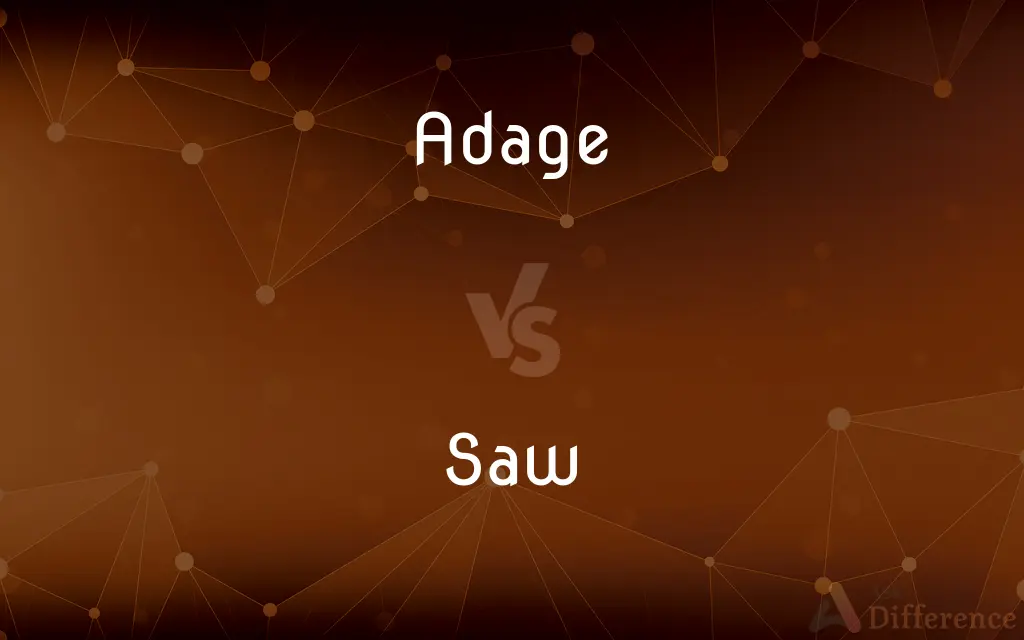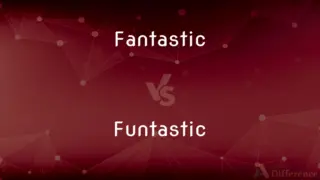Adage vs. Saw — What's the Difference?
By Tayyaba Rehman & Urooj Arif — Updated on April 8, 2024
An adage is a traditional saying expressing a common truth or wisdom, while a saw is a proverb or maxim, often more colloquial or rustic in nature.

Difference Between Adage and Saw
Table of Contents
ADVERTISEMENT
Key Differences
An adage is a short, memorable, and usually wise saying that encapsulates a general truth or practical precept, often passed down through generations. On the other hand, a saw, while similar in being a proverbial expression, tends to be less formal and more vernacular, sometimes embodying folk wisdom or practical insights in a straightforward manner.
Adages are often used in literature, speeches, and daily conversation to convey wisdom or moral lessons in an impactful way. They are respected for their age and the universal truths they often embody. Saws, while also conveying truths or observations, can have a more homespun quality, making them relatable and easily understood in everyday contexts.
The language of an adage tends to be more polished and timeless, making it applicable across different cultures and eras. In contrast, a saw might contain regional dialects or colloquialisms, which gives it a more specific cultural or local flavor, but also may limit its universality.
Adages are revered for their philosophical or ethical insights, often reflecting on human nature, society, or life's challenges. Saws, conversely, might focus more on practical wisdom, offering advice or observations that are useful in day-to-day life but might not delve as deeply into philosophical or ethical considerations.
While adages are often cited to inspire, provoke thought, or offer guidance, saws are frequently used to add color to conversation, underscore common experiences, or impart simple truths in a manner that is immediate and accessible.
ADVERTISEMENT
Comparison Chart
Nature
Wise saying, often philosophical
Proverbial, often practical
Tone
Formal, timeless
Colloquial, rustic
Universality
Broad, applicable across cultures
May contain local dialects or colloquialisms
Focus
Philosophical insights, moral lessons
Practical wisdom, day-to-day advice
Usage
Literature, formal speeches, philosophical discussions
Everyday conversation, practical contexts
Compare with Definitions
Adage
A saying that imparts ethical guidance.
The adage Do unto others as you would have them do unto you advises on treating others well.
Saw
A proverb or maxim expressing a truth based on common sense or practical experience.
Measure twice, cut once is a saw in carpentry advising careful planning.
Adage
A wise saying that has gained credibility over time through widespread use.
Time heals all wounds is an adage offering comfort.
Saw
A traditional saying that is widely used in everyday conversation.
Early to bed and early to rise, makes a man healthy, wealthy, and wise is a saw advocating for a disciplined lifestyle.
Adage
A traditional saying with moral content.
The adage Honesty is the best policy teaches the value of truthfulness.
Saw
A rustic or folk saying that imparts practical knowledge.
A stitch in time saves nine is a saw emphasizing timely effort to prevent more work later.
Adage
An expression that encapsulates the wisdom of the collective experience.
Actions speak louder than words, is an adage emphasizing the importance of deeds over promises.
Saw
An expression used to convey straightforward, practical advice or truths.
Out of sight, out of mind is a saw reflecting on the nature of human attention and attachment.
Adage
A proverb or short statement expressing a general truth.
A penny saved is a penny earned, is an adage promoting frugality.
Saw
A colloquial saying that often incorporates humor or rural wisdom.
Don't count your chickens before they hatch is a saw cautioning against premature optimism.
Adage
An adage (; Latin: adagium) is a concise, memorable, and usually philosophical aphorism that communicates an important truth derived from experience, custom, or both, and that many people consider true and credible because of its longeval tradition, i.e. being handed down generation to generation, or memetic replication.
Saw
A saw is a tool consisting of a tough blade, wire, or chain with a hard toothed edge. It is used to cut through material, very often wood though sometimes metal or stone.
Adage
A proverb or short statement expressing a general truth
The old adage ‘out of sight out of mind’
Saw
Any of various tools, either hand-operated or power-driven, having a thin metal blade or disk with a sharp, usually toothed edge, used for cutting wood, metal, or other hard materials.
Adage
A saying that sets forth a general truth and that has gained credit through long use. See Usage Note at redundancy.
Saw
A familiar saying, especially one that has become trite through repetition.
Adage
An old saying which has obtained credit by long use.
Saw
To cut or divide with a saw.
Adage
An old saying which has been overused or considered a cliché; a trite maxim.
Saw
To produce or shape with a saw
Sawed a hole in the board.
Adage
An old saying, which has obtained credit by long use; a proverb.
Letting "I dare not" wait upon "I would,"Like the poor cat i' the adage.
Saw
To make back-and-forth motions through or on
A speaker who saws the air with his arms.
Adage
A condensed but memorable saying embodying some important fact of experience that is taken as true by many people
Saw
To use a saw
Sawing along the chalk line.
Saw
To undergo cutting with a saw
Pine wood saws easily.
Saw
Past tense of see1.
Saw
A tool with a toothed blade used for cutting hard substances, in particular wood or metal.
Saw
Such a tool with an abrasive coating instead of teeth.
Saw
A musical saw.
Saw
A sawtooth wave.
Saw
(obsolete) Something spoken; speech, discourse.
Saw
(archaic) A saying or proverb.
Old saw
Saw
(obsolete) Opinion, idea, belief.
Saw
(obsolete) Proposal, suggestion; possibility.
Saw
(obsolete) Dictate; command; decree.
Saw
(transitive) To cut (something) with a saw.
Saw
(intransitive) To make a motion back and forth similar to cutting something with a saw.
Saw
(intransitive) To be cut with a saw.
The timber saws smoothly.
Saw
(transitive) To form or produce (something) by cutting with a saw.
To saw boards or planks (i.e. to saw logs or timber into boards or planks)
To saw shingles
To saw out a panel
Saw
Something said; speech; discourse.
Saw
A saying; a proverb; a maxim.
His champions are the prophets and apostles,His weapons holy saws of sacred writ.
Saw
Dictate; command; decree.
[Love] rules the creatures by his powerful saw.
Saw
An instrument for cutting or dividing substances, as wood, iron, etc., consisting of a thin blade, or plate, of steel, with a series of sharp teeth on the edge, which remove successive portions of the material by cutting and tearing.
Saw
To cut with a saw; to separate with a saw; as, to saw timber or marble.
Saw
To form by cutting with a saw; as, to saw boards or planks, that is, to saw logs or timber into boards or planks; to saw shingles; to saw out a panel.
Saw
Also used figuratively; as, to saw the air.
Saw
To use a saw; to practice sawing; as, a man saws well.
Saw
To cut, as a saw; as, the saw or mill saws fast.
Saw
To be cut with a saw; as, the timber saws smoothly.
Saw
A condensed but memorable saying embodying some important fact of experience that is taken as true by many people
Saw
Hand tool having a toothed blade for cutting
Saw
A power tool for cutting wood
Saw
Cut with a saw;
Saw wood for the fireplace
Common Curiosities
Are adages considered more formal than saws?
Yes, adages are generally considered more formal and timeless, while saws are more colloquial and may include local dialects or expressions.
Can adages and saws overlap in meaning or use?
Yes, adages and saws can overlap in their conveyance of wisdom or truth, but they differ in tone and often in the scope of their wisdom (philosophical vs. practical).
How are adages used in literature?
Adages are used in literature to provide insight, underscore themes, or convey universal truths through concise, memorable phrasing.
Do saws lose relevance outside their cultural or regional context?
Saws might lose some immediacy or relevance outside their original context due to regional dialects or specific cultural references but can still convey practical wisdom.
Can a saying be both an adage and a saw?
A saying might function as both depending on its use and context; however, it's typically classified by its predominant characteristics (philosophical wisdom vs. practical advice).
What distinguishes an adage from a saw?
An adage is a wise saying expressing a general truth or principle, often philosophical, while a saw is a more colloquial or rustic proverb focusing on practical wisdom.
Are there any genres or forms of literature where saws are particularly prevalent?
Saws are particularly prevalent in folklore, fables, and regional literature, where they serve to impart moral lessons or practical advice through storytelling.
Is the universality of an adage important?
Yes, the universality of an adage is important as it reflects its applicability and relevance across different cultures and times.
How do adages reflect on human nature?
Adages often reflect on human nature by encapsulating observations about behaviors, ethics, and societal norms in a succinct and impactful way.
Can the tone of a saw affect its interpretation?
Yes, the tone of a saw, often colloquial or humorous, can influence its interpretation and the impact of its wisdom, making it more relatable or memorable.
How do adages contribute to cultural heritage?
Adages contribute to cultural heritage by encapsulating and transmitting the collective wisdom, values, and philosophies of a society across generations.
How do saws reflect the character of a community or region?
Saws reflect the character of a community or region by embodying local wisdom, experiences, and values, often revealing insights into the community's way of life, beliefs, and social mores.
Why are saws important in everyday conversation?
Saws add color and relatability to conversations, offering practical advice or observations in a straightforward, often humorous manner.
Why might some adages become less relevant over time?
Some adages may become less relevant due to changes in societal values, technological advancements, or shifts in cultural norms that affect their applicability or resonance.
Share Your Discovery

Previous Comparison
Fantastic vs. Funtastic
Next Comparison
Abyss vs. LimboAuthor Spotlight
Written by
Tayyaba RehmanTayyaba Rehman is a distinguished writer, currently serving as a primary contributor to askdifference.com. As a researcher in semantics and etymology, Tayyaba's passion for the complexity of languages and their distinctions has found a perfect home on the platform. Tayyaba delves into the intricacies of language, distinguishing between commonly confused words and phrases, thereby providing clarity for readers worldwide.
Co-written by
Urooj ArifUrooj is a skilled content writer at Ask Difference, known for her exceptional ability to simplify complex topics into engaging and informative content. With a passion for research and a flair for clear, concise writing, she consistently delivers articles that resonate with our diverse audience.















































